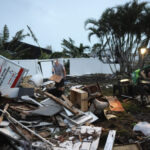The Montana Supreme Court on Tuesday ordered the creation of a special court to oversee hundreds of claims filed on behalf of people who became ill or died following exposure to asbestos from the now-closed W.R. Grace Inc. vermiculite mine in northwestern Montana.
With at least 540 lawsuits pending and Grace’s bankruptcy proceedings complete, justices said there was sufficient need to create the Asbestos Claims Court under an act passed by lawmakers in 2001.
The court appointed District Judge Amy Eddy of Kalispell to oversee pretrial proceedings. She said she will set trial management plans for the scientifically and medically complicated cases, many of which date to the early 2000s.
“It’s an enormous responsibility and we need to bring resolution for all these claimants and the defendants,” Eddy said.
Defendants include the state of Montana, BNSF Railway, International Paper Co. and Maryland Casualty Co.
Asbestos-containing vermiculite and products made from it have killed as many as 400 people and sickened close to 3,000 in the town of Libby and surrounding communities, health officials have said.
Some 2,000 plaintiffs – miners, their family members and members of the Libby community – previously settled claims against the state for failing to protect them. Asbestos dangers at the Grace mine were first identified by state officials in the 1950s.
Those settlements in 2011 and earlier this year totaled $68 million.
Cases continue to be filed against the state and other defendants because asbestos-related diseases have a long latency period.
Asbestos fibers can cause lung cancers such as mesothelioma decades after exposure. Families of Grace miners were exposed to asbestos brought home as dust on the miners’ clothing and others were exposed by the use of vermiculite at construction sites and in residential insulation.
Maryland Casualty Co. was Grace’s insurer and is alleged to have known about the contamination. International Paper is the current owner of a lumber mill in Libby that is accused of knowingly using asbestos-tainted vermiculite in its operations.
Tuesday’s order gave the plaintiffs’ attorneys 30 days to file notices of appearance with the Asbestos Claims Court. Eddy expects the number of cases could be closer to 1,000. Cases that go to trial will be heard in the district in which they were filed.
Kalispell attorney Roger Sullivan, who is representing numerous clients in the pending cases, said consolidating claims in the newly created court will allow for patients with more severe conditions to have their cases prioritized.
“It will provide a framework for the fair and efficient management of a challenging number of cases,” said Sullivan, whose firm has been involved in asbestos cases for more than 20 years.
The pretrial proceedings are likely to be held in Helena, Eddy said, although a schedule has not been set.
While the 2001 Legislature passed the Asbestos Claims Court Act, it did not fund the court. The Department of Justice will seek that funding during the 2019 legislative session.
The Libby mine closed in 1999 and a federally-sponsored cleanup of the town began in 2000.
Legal claims against W.R. Grace were put on hold after the company declared bankruptcy in 2001. Those claims are now being handled through a special trust that was formed after the company emerged from bankruptcy in 2014.
The Maryland-based company agreed in a 2008 settlement to pay the U.S. Environmental Protection Agency $250 million for cleanup work. The cost of that cleanup reached $575 million in 2016 and continues to climb.
Was this article valuable?
Here are more articles you may enjoy.

 Mattel Settles Baby Sleeper Death Suits Before Start of a Trial
Mattel Settles Baby Sleeper Death Suits Before Start of a Trial  Fixing the Claims Experience Where It Matters Most: In the Mess
Fixing the Claims Experience Where It Matters Most: In the Mess  Here Comes Another Busy Atlantic Hurricane Season, But Will It Be as Crazy as 2024?
Here Comes Another Busy Atlantic Hurricane Season, But Will It Be as Crazy as 2024?  Delivery Hero Hit by $376 Million Fine for Glovo Cartel
Delivery Hero Hit by $376 Million Fine for Glovo Cartel 